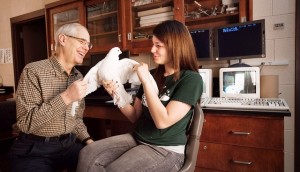Do pigeons put off until tomorrow what they could do today? It’s hard to say, but the birds can still be useful in studying the problem of procrastination.
In his behavioral research lab, Robert Allan, associate professor of psychology, uses pigeons to study a variety of behaviors with the help of psychology major and research assistant Julia Brodsky ’13 (East Meadow, N.Y.)

Robert Allan, associate professor of psychology, and Julia Brodsky ’13 interact with a bird in Allan’s lab.
The pigeons are placed into operant conditioning chambers, also known as “Skinner boxes” after famous behaviorist B.F. Skinner, who invented them. Pigeons receive food for pecking a small dot on a computer monitor with a touch screen positioned to accumulate responses to the dot.
In the current experiment, each peck to the dot moves it 5 pixels to the right. In one condition, a short vertical line signals the location to which the dot must be pecked, after which a short food delivery follows. The vertical line can be close to the dot (at the start of a trial) or far away on the other side of the computer monitor. When it’s far away, the pigeons pause before beginning to respond; when it’s close the dot, the pigeons do not pause but begin responding immediately. There are 80 possible positions for the vertical line.
Studying how the pigeons respond provides information on post-reinforcement pausing, which occurs when an organism ceases responding after having completed one task prior to starting a new one. In some ways, this is analogous to procrastination in humans.
Brodsky has been assisting Allan in his research through the EXCEL Scholars undergraduate research program. She has also worked with him on related research for her honors thesis.
Conducting this sort of research requires running the experiment every day, even on weekends. Each of the pigeons used in the study must complete one session per day, with 40 trials per session. Brodsky records data from these sessions, makes sure the experiment runs smoothly, and feeds the pigeons. She also helps in the analysis of the data and plotting of results.
“Prior to starting EXCEL research, I was not sure that I wanted to continue doing research past the undergraduate level. But, after working in the lab almost every day since the beginning of the summer, I’m now very excited and passionate about the research I do, and really want to continue,” she says. “This research is incredibly useful in helping me accomplish these goals. I now know how much effort and enthusiasm is necessary to conduct research.”
Brodsky has an eye toward teaching at the college level, and plans to continue studying behavior analysis in graduate school. Allan has helped her with the graduate school process.
“She has observed how behavior changes as a function of changing environmental conditions. Many of us are too close to our behavior and the behavior of others to see it change. As a result, Julia has altered her plans for graduate work. She is an amazing person, indeed,” Allan says.
